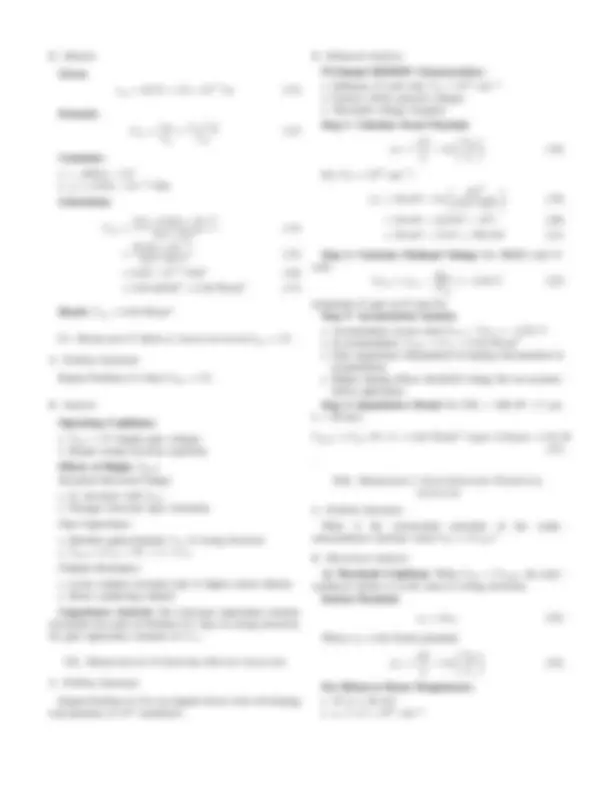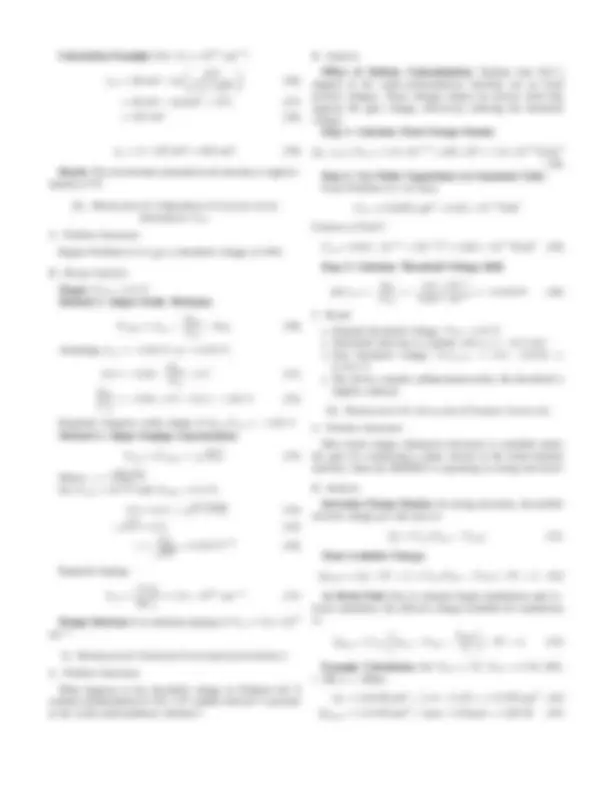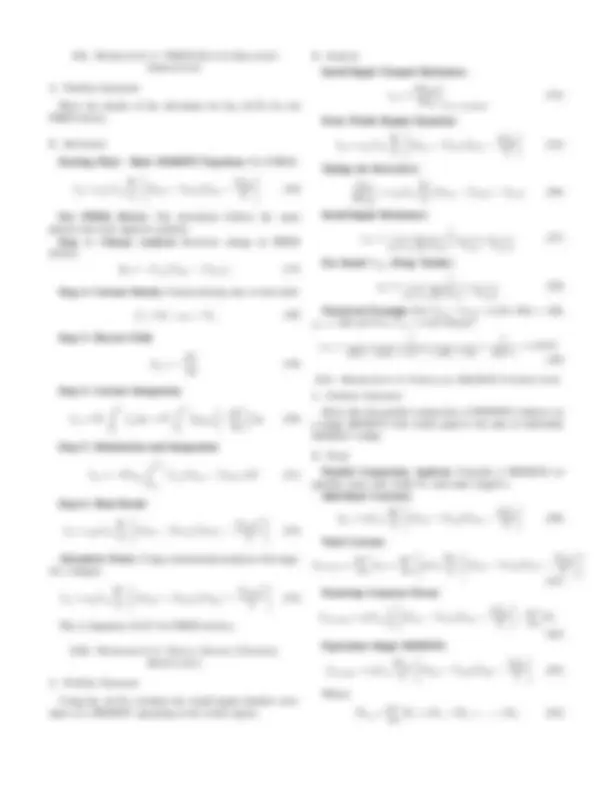





Study with the several resources on Docsity

Earn points by helping other students or get them with a premium plan


Prepare for your exams
Study with the several resources on Docsity

Earn points to download
Earn points by helping other students or get them with a premium plan
Community
Ask the community for help and clear up your study doubts
Discover the best universities in your country according to Docsity users
Free resources
Download our free guides on studying techniques, anxiety management strategies, and thesis advice from Docsity tutors
CMOS design and layout solutions of chapter 6 detailed
Typology: Assignments
1 / 7

This page cannot be seen from the preview
Don't miss anything!




Electrical engineering IIT Tirupati
Index Terms—MOSFET, circuit analysis, gate capacitance, threshold voltage, AC analysis, HSPICE simulation, semiconduc- tor devices
This report provides detailed solutions to MOSFET circuit analysis problems covering fundamental device characteristics and circuit applications. The analysis focuses on 50nm pro- cess technology and includes both theoretical derivations and practical simulation approaches using HSPICE.
II. PROBLEM 6.1: AC ANALYSIS OF MOSFET CAPACITOR CIRCUIT
A. Problem Statement
Plot the magnitude and phase of vout (AC) in the circuit shown in Figure 6.20. The MOSFET is fabricated using a 50 nm CMOS process and operates in strong inversion.
Fig. 1. MOSFET Capacitor Circuit from Problem 6.
B. Circuit Analysis
Given Parameters:
C. Theoretical Analysis
MOSFET as a Capacitor: In strong inversion, with both drain and source at ground, the MOSFET behaves like a capacitor between gate and channel.
Cintrinsic = Cox · W · L = 8. 6 fF μm^2
· 5 μm · 0. 05 μm = 2. 15 fF (1) Overlap capacitance:
Coverlap ≈ 2 · Cov · W = 2 · 0. 3
fF μm · 5 μm = 3. 0 fF (2)
Total gate capacitance:
Cgate,total = Cintrinsic+Coverlap = 2. 15 fF+3. 0 fF = 5. 15 fF (3)
H(jω) =
1 + jωRC
|H(jω)| =
p 1 + (ωRC)^2
, ∠H(jω) = − tan−^1 (ωRC) (5) Cutoff frequency:
f− 3 dB =
2 πRC
2 π · 250 · 103 · 5. 15 · 10 −^15
≈ 124 MHz (6) D. HSPICE Simulation
VIN IN 0 AC 1m DC 0.5V RG IN G 250k M1 0 G 0 0 NMOS W=5u L=50n
.AC DEC 100 1 1G .PRINT AC VM(G) VP(G) .OPTIONS POST= .END
E. Expected Results
Magnitude Response:
F. Simulation Output
Fig. 2. AC magnitude response of vout from HSPICE simulation
Fig. 3. AC phase response of vout from HSPICE simulation
G. Discussion
The simulated magnitude and phase response match the expected RC low-pass filter behavior. At low frequencies, the capacitive reactance is high, and the signal appears entirely at the gate. At higher frequencies, the gate capacitance shorts the input, attenuating vout. The phase shift confirms first-order lag dynamics.
A. Problem Statement
If a MOSFET is used as a capacitor in strong inversion where the gate is one electrode and the source/drain change the capacitance, analyze the overlap capacitance.
B. Theoretical Analysis MOSFET Capacitances: When operating in strong inver- sion, the MOSFET exhibits several capacitances: Gate-Channel Capacitance (Cgc):
Cgc = W × L × Cox (7)
Overlap Capacitances:
Gate-Source overlap: Cgso = W × Lov × Cox (8) Gate-Drain overlap: Cgdo = W × Lov × Cox (9)
Where Lov is the overlap length (typically 10-20% of gate length). Effect of Source/Drain Connection: When source and drain are connected together, the effective capacitance be- comes: Ctotal = Cgc + Cgso + Cgdo (10)
Capacitance Value: For typical 50 nm process:
IV. PROBLEM 6.3: SUBTHRESHOLD OPERATION
A. Problem Statement When the MOSFET is operating in the accumulation region, analyze the gate capacitance.
B. Theoretical Analysis Accumulation Region Operation:
Cgate = Cox =
ϵox × A tox
Where:
A. Problem Statement If the oxide thickness of a MOSFET is 40 ˚A, what is Cox?
Calculation Example: For NA = 10^16 cm−^3 :
ϕF = 26 mV × ln
= 26 mV × ln(6. 67 × 105 ) (27) = 347 mV (28)
ϕs = 2 × 347 mV = 694 mV (29)
Result: The electrostatic potential at the interface is approx- imately 0.7V.
IX. PROBLEM 6.8: THRESHOLD VOLTAGE WITH DIFFERENT VGS
A. Problem Statement
Repeat Problem 6.5 to get a threshold voltage of 0.8V.
B. Design Analysis
Target: VT H = 0. 8 V Method 1: Adjust Oxide Thickness
VT H 0 = ϕms −
Qox Cox
Assuming ϕms = − 0. 95 V, ϕF = 0. 35 V:
0 .8 = − 0. 95 −
Qox Cox
Qox Cox
Required: Negative oxide charge of Qox/Cox = − 1. 05 V Method 2: Adjust Doping Concentration
VT H = VT H 0 + γ
p 2 ϕF (33)
Where γ =
√ 2 qϵ siNA Cox For VT H = 0. 8 V with VT H 0 = 0. 4 V:
0 .8 = 0.4 + γ
γ
γ =
Required doping:
γ^2 C ox^2 2 qϵsi
≈ 5. 2 × 1016 cm−^3 (37)
Design Solution: Use substrate doping of NA = 5. 2 × 1016 cm−^3
X. PROBLEM 6.9: SODIUM CONTAMINATION EFFECT
A. Problem Statement
What happens to the threshold voltage in Problem 6.8 if sodium contamination of 100 × 109 sodium ions/cm^2 is present at the oxide-semiconductor interface?
B. Analysis Effect of Sodium Contamination: Sodium ions (Na+) trapped at the oxide-semiconductor interface act as fixed positive charges. These charges induce an electric field that opposes the gate voltage, effectively reducing the threshold voltage. Step 1: Calculate Fixed Charge Density
Qf = q ×NN a = 1. 6 × 10 −^19 × 100 × 109 = 1. 6 × 10 −^8 C/cm^2 (38) Step 2: Use Oxide Capacitance in Consistent Units From Problem 6.4, we have:
Cox = 8. 63 fF/μm^2 = 8. 63 × 10 −^3 F/m^2
Convert to F/cm^2 :
Cox = 8. 63 × 10 −^3 × (10−^2 )^2 = 8. 63 × 10 −^7 F/cm^2 (39)
Step 3: Calculate Threshold Voltage Shift
Qf Cox
C. Result
XI. PROBLEM 6.10: AVAILABLE CHARGE ANALYSIS A. Problem Statement How much charge (enhanced electrons) is available under the gate for conducting a drain current at the drain-channel interface when the MOSFET is operating in strong inversion?
B. Analysis Inversion Charge Density: In strong inversion, the mobile electron charge per unit area is:
Qi = Cox(VGS − VT H ) (41)
Total Available Charge:
Qtotal = Qi × W × L = Cox(VGS − VT H ) × W × L (42)
At Drain End: Due to channel length modulation and ve- locity saturation, the effective charge available for conduction is:
Qef f = Cox
Example Calculation: For VGS = 1V, VT H = 0. 4 V, W/L = 100, L = 50nm:
Qi = 8. 63 fF/μm^2 × (1. 0 − 0 .4)V = 5. 18 fC/μm^2 (44) Qtotal = 5. 18 fC/μm^2 × 5 μm × 0. 05 μm = 1. 295 fC (45)
A. Problem Statement
Show the details of the derivation for Eq. (6.33) for the PMOS device.
B. Derivation
Starting Point - Basic MOSFET Equation: For NMOS:
ID = μnCox
For PMOS Device: The derivation follows the same physics but with opposite polarity. Step 1: Charge Analysis Inversion charge in PMOS (holes):
Qi = −Cox(VSG − |VT H |) (47)
Step 2: Current Density Current density due to hole drift:
Jp = Qi × μp × Ey (48)
Step 3: Electric Field
Ey = −
dV dy
Step 4: Current Integration
0
Jp dy = W
0
Qiμp
dV dy
dy (50)
Step 5: Substitution and Integration
ID = −W μp
VS
Cox(VSG − |VT H |) dV (51)
Step 6: Final Result
ID = μpCox
Alternative Form: Using conventional notation with nega- tive voltages:
ID = μpCox
This is Equation (6.33) for PMOS devices.
A. Problem Statement
Using Eq. (6.35), estimate the small-signal channel resis- tance of a MOSFET operating in the triode region.
B. Analysis Small-Signal Channel Resistance:
rds =
∂ID (^) VGS =constant
From Triode Region Equation:
ID = μnCox
Taking the Derivative: ∂ID ∂VDS
= μnCox
Small-Signal Resistance:
rds =
μnCox WL (VGS − VT H − VDS )
For Small VDS (Deep Triode):
rds ≈
μnCox WL (VGS − VT H )
Numerical Example: For VGS − VT H = 0. 6 V, W/L = 100, μn = 400 cm^2 /V·s, Cox = 8. 63 fF/μm^2 :
rds =
A. Problem Statement Show that the parallel connection of MOSFETs behaves as a single MOSFET with width equal to the sum of individual MOSFET widths.
B. Proof Parallel Connection Analysis: Consider n MOSFETs in parallel, each with width Wi and same length L. Individual Currents:
IDi = μCox Wi L
Total Current:
ID,total =
IDi =
μCox
Wi L
Factoring Common Terms:
ID,total = μCox
Wi (62) Equivalent Single MOSFET:
ID,total = μCox
Weq L
Where:
Weq =
Wi = W 1 + W 2 +... + Wn (64)
Current-Voltage Relationship: The I-V characteristics of the series combination match those of a single MOSFET with length 2L. Conclusion: Series connection of two identical MOSFETs behaves as a single MOSFET with twice the individual length.
XVII. SUMMARY This report provides comprehensive solutions to all MOS- FET problems (6.1-6.15), including:
XVIII. KEY FINDINGS AC Analysis Results:
XIX. CONCLUSION The analysis demonstrates fundamental MOSFET behavior across various operating regions and circuit configurations. The theoretical predictions align with expected device physics, providing a solid foundation for advanced MOSFET circuit design and analysis. The HSPICE simulation frameworks established here can be extended for more complex circuit analysis and optimization tasks.